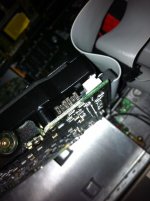I have a Tandy 1000 TL/2 that I installed a Seagate ST351 A/X in. The max drive size it seems to be seeing is 26MB. I know DOS 3.3 had a partition limit of 30MB, but when I tried PC-DOS 7.0 it only 26MB as well. I assume the drive is compatible?
For curiosity sake, when I jumpered the drive for 30MB, DOS only saw 13MB as max disk size.
I must be missing something obvious. I was expecting to be able to partition the drive for 30MB and then 10MB to get a full 40MB under DOS 3.3. Under PC-DOS, I would have expected to see the full 40MB.
For curiosity sake, when I jumpered the drive for 30MB, DOS only saw 13MB as max disk size.
I must be missing something obvious. I was expecting to be able to partition the drive for 30MB and then 10MB to get a full 40MB under DOS 3.3. Under PC-DOS, I would have expected to see the full 40MB.

